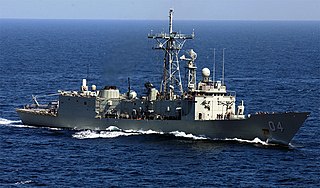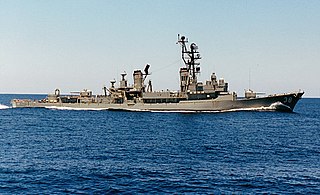
The Oliver Hazard Perry class is a class of guided-missile frigates named after U.S. Commodore Oliver Hazard Perry, the hero of the naval Battle of Lake Erie. Also known as the Perry or FFG-7 class, the warships were designed in the United States in the mid-1970s as general-purpose escort vessels inexpensive enough to be bought in large numbers to replace World War II-era destroyers and complement 1960s-era Knox-class frigates.

HMAS Darwin, named for the capital city of the Northern Territory, was an Adelaide-class guided-missile frigate, formerly in service with the Royal Australian Navy (RAN). One of four ships ordered from the United States, Darwin entered service in 1984. During her career, she has operated in the Persian Gulf, as part of the INTERFET peacekeeping taskforce, and off the Solomon Islands. The frigate underwent a major upgrade during 2007 and 2008. She was decommissioned on 9 December 2017 and was supposed to be scuttled as a dive wreck in Tasmania, but the deal was pulled by the Tasmanian Government and her fate remains uncertain.

HMAS Newcastle, named for the city of Newcastle, New South Wales, the largest provincial city in Australia, was an Adelaide-class guided-missile frigate. The last ship of the class to be constructed, Newcastle entered service with the Royal Australian Navy in 1993. During her career, the frigate has operated as part of the INTERFET peacekeeping taskforce, served in the Persian Gulf, and responded to the 2006 Fijian coup d'état. The frigate was decommissioned on 30 June 2019 and transferred to the Chilean Navy on 15 April 2020 and renamed as Capitán Prat.

HMAS Adelaide was the lead ship of the Adelaide class of guided missile frigates built for the Royal Australian Navy (RAN), based on the United States Navy's Oliver Hazard Perry-class frigates. She was built in the United States and commissioned into the RAN in 1980.

The Anzac class is a ship class of ten frigates; eight operated by the Royal Australian Navy (RAN) and two operated by the Royal New Zealand Navy (RNZN). During the 1980s, the RAN began plans to replace the River-class destroyer escorts with a mid-capability patrol frigate and settled on the idea of modifying a proven German design for Australian conditions. Around the same time, the RNZN was seeking to replace their Leander-class frigates while maintaining blue-water capabilities. A souring of relations between New Zealand and the United States of America in relation to New Zealand's nuclear-free zone and the ANZUS security treaty prompted New Zealand to seek improved ties with other nations, particularly Australia. As both nations were seeking warships of similar capabilities, the decision was made in 1987 to collaborate on their acquisition. The project name is taken from the Australian and New Zealand Army Corps of the First World War.

HMAS Parramatta is an Anzac-class frigate of the Royal Australian Navy (RAN). One of ten warships built for the RAN and Royal New Zealand Navy (RNZN) based on the MEKO 200 design, Parramatta was laid down in 1999, launched in 2003, and commissioned into the RAN in 2003. During her career, the frigate has been deployed to the Middle East on several occasions. In early 2015, Parramatta was docked to undergo the Anti-Ship Missile Defence (ASMD) upgrade. She completed these upgrades in April 2016.

HMAS Stuart is an Anzac-class frigate of the Royal Australian Navy (RAN). She was built at Williamstown in Victoria, and commissioned into the RAN in 2002. The frigate is operational as of 2021.

HMAS Sydney was an Adelaide-class guided-missile frigate of the Royal Australian Navy (RAN). The frigate was one of six modified Oliver Hazard Perry-class frigates ordered from 1977 onwards, and the third of four to be constructed in the United States of America. Laid down and launched in 1980, Sydney was named for the capital city of New South Wales, and commissioned into the RAN in 1983.

HMAS Anzac is the lead ship of the Anzac-class frigates in use with the Royal Australian Navy (RAN) and the Royal New Zealand Navy (RNZN). Entering Australian service in 1996, the frigate operated as part of the INTERFET peacekeeping taskforce in 1999. In 2003, she was involved in the Battle of Al Faw, and became the first RAN ship to fire in anger since the Vietnam War. The ship is operational as of 2021.

HMAS Arunta is an Anzac-class frigate of the Royal Australian Navy (RAN). The ship, named for the Arrernte people, was laid down in 1995 and commissioned in 1998. Since entering service, Arunta has performed a wide range of duties, including border protection patrols in northern Australian waters, and several deployments to the Persian Gulf.

HMAS Perth is an Anzac-class frigate of the Royal Australian Navy (RAN). The last ship of the class to be completed, she was built by Tenix Defence and commissioned into the RAN in 2006. In 2007, Perth became the first major warship of the RAN to be commanded by a woman. During 2010 and 2011, the frigate was used as the testbed for a major upgrade to the Anzac class' ability to defend themselves from anti-ship missiles.

HMAS Toowoomba is the seventh Anzac-class frigate of the Royal Australian Navy (RAN). She was laid down in 2002 by Tenix Defence and commissioned in 2005.

HMAS Warramunga is an Anzac-class frigate of the Royal Australian Navy (RAN). One of ten frigates built for the Australian and New Zealand navies, Warramunga was laid down by Tenix Defence in 1997 and commissioned in 2001. During her career, the frigate has operated in the Persian Gulf as part of Operation Catalyst, and undertaken anti-piracy operations off Somalia. Warramunga underwent the Anti-Ship Missile Defence (ASMD) upgrade during 2014. She is active as of October 2022.

HMAS Ballarat is an Anzac-class frigate of the Royal Australian Navy (RAN). The frigate was laid down in 2000 and commissioned into the RAN in mid-2004. Since entering service, Ballarat has been involved in border protection as part of Operation Relex II, was deployed to the Gulf for Operation Catalyst, and was one of the two ships involved in the Operation Northern Trident 2009 round-the-world voyage. Ballarat has undergone the Anti-Ship Missile Defence (ASMD) upgrade, completing in 2015.

HMAS Canberra was an Adelaide class guided missile frigate of the Royal Australian Navy (RAN). Based on the Oliver Hazard Perry class design, Canberra was one of four Adelaide class ships constructed in the United States of America, and one of six to serve in the RAN.

Mark 32 Surface Vessel Torpedo Tubes is a torpedo launching system designed for the United States Navy.
The Royal Australian Navy, although a significant force in the Asia-Pacific region, is nonetheless classed as a medium-sized navy. Its fleet is based around two main types of surface combatant, with limited global deployment and air power capability. However, in 2009, a white paper, Defending Australia in the Asia Pacific Century: Force 2030, was produced by the Australian government which set out a programme of defence spending that will see significant improvements to the RAN's fleet and capabilities.

The Adelaide class of six guided missile frigates was constructed in Australia and the United States for service in the Royal Australian Navy. Two were later sold to the Chilean Navy. The Adelaide class was based on the United States Navy's Oliver Hazard Perry-class frigates, but modified for Australian requirements. The first four vessels were built in the United States, and the final two were constructed in Australia. The first ship entered service in November 1980.

The Perth-class destroyers were three modified Charles F. Adams-class guided missile destroyers operated by the Royal Australian Navy (RAN). Ordered from Defoe Shipbuilding Company during 1962 and 1963, HMA Ships Perth, Hobart, and Brisbane were the first guided missiled-armed warships, and the first naval ships of United States design, to enter service with the RAN. All three ships operated during the Vietnam War, while Brisbane also participated in the Gulf War. The class was decommissioned between 1999 and 2001, with all three vessels later sunk as dive wrecks.

Australia was a member of the international coalition which contributed military forces to the 1991 Gulf War, also known as Operation Desert Storm. More than 1,800 Australian Defence Force (ADF) personnel were deployed to the Persian Gulf from August 1990 to September 1991, while contingents from the Royal Australian Navy circulated through the region in support of the sanctions against Iraq until November 2001. In August 1990, two frigates HMAS Adelaide and HMAS Darwin and the replenishment ship HMAS Success left for the Persian Gulf. HMAS Success had no air defences, so the Army 16th Air Defence Regiment was embarked. On 3 December 1990, HMAS Brisbane and HMAS Sydney (IV) relieved HMAS Adelaide and HMAS Darwin. On 26 January 1991, HMAS Westralia replaced HMAS Success. A Navy clearance diving team was also deployed for explosive ordnance disposal and demolition tasks. Australian ships were in danger of sea mines and possible air attacks. In a number of recorded incidents, HMAS Brisbane encountered free floating mines, on one occasion narrowly avoiding a collision. Both HMA Ships Brisbane and Sydney encountered significant air threat warnings from Iran and Iraq throughout the initial period of the commencement of the Desert Storm Campaign. The detection of land based Silkworm anti-ship missiles from Iran throughout the campaign also added to the challenges for both crews as well as the multi-national Naval Forces.






















